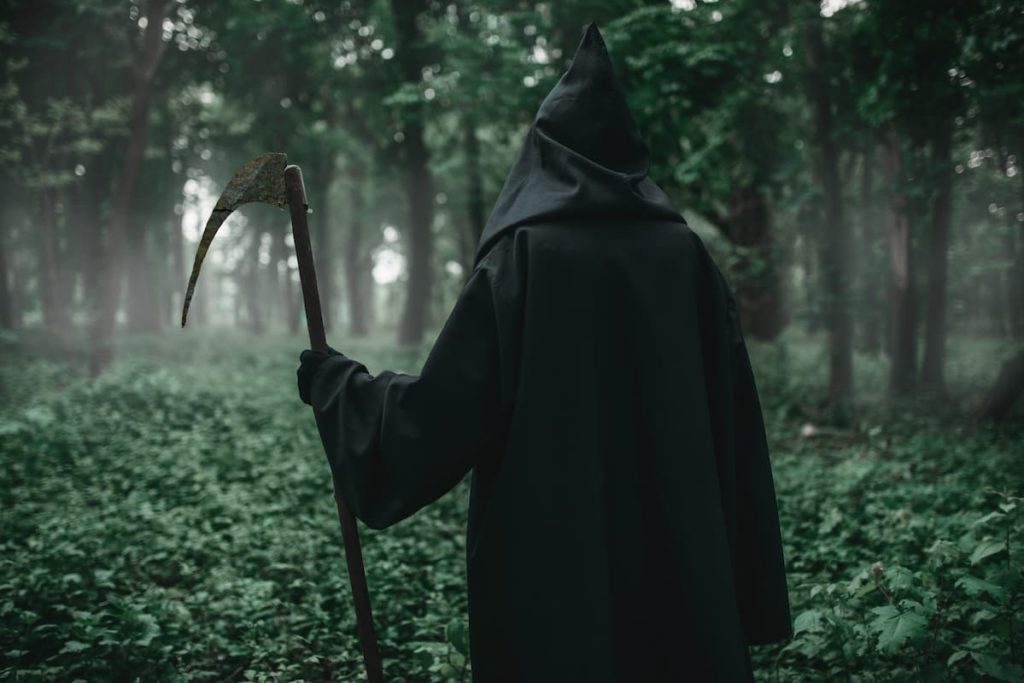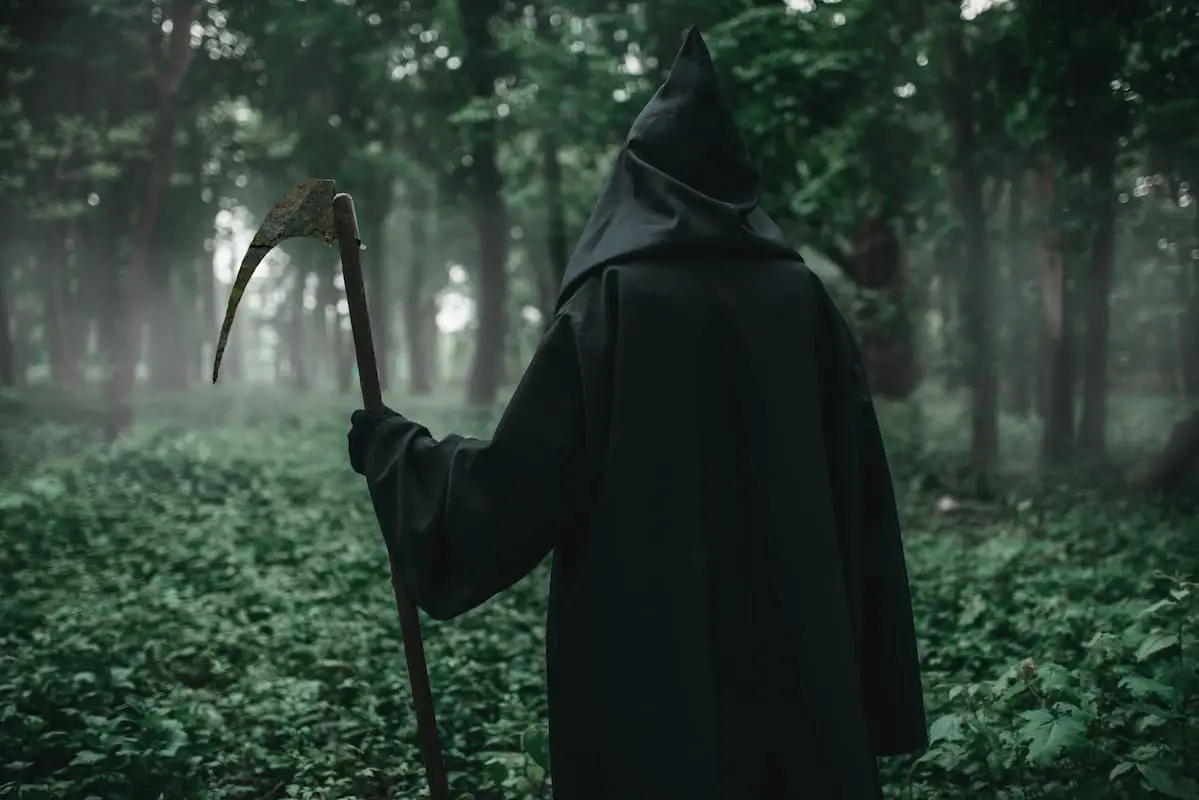Father Time is the personification of time and typically has a harvester’s stickle, while The Grim Reaper is the personification of death and often has with him a scythe. They are two distinctly different characters in folklore. However, they also share a bond, because, with the inevitable and unstoppable passing of time, the result is always eventually, without exception, death.
One of my fondest memories is of my first day of Freshman year at University. The mandatory campus tour was led by an extremely old, long-bearded gentleman unofficially known to everyone as ‘Father Time.’ No one knew how old he was or how long he had worked at the University. He seemed to be able to evade his inevitable meeting with The Grim Reaper consistently, and year after year would appear to welcome the Freshman students.
This may seem confusing, but, in reality, the two characters differ dramatically in both appearance and roles. They are often depicted together in popular culture and art, as they are inevitably tied to one another. Knowing the differences will not only improve your general knowledge but may be valuable information when selecting a fun outfit for Halloween or New Year celebrations.

Related Reading: How To Summon A Dad (3 Different Ways)
Who is Father Time?
Every New Year, we see cartoon images depicting Father Time as an old man wearing a sash bearing the year that is about to pass accompanied by a tiny baby representing the incoming year. The passing of time cannot be stopped and it is this attribute that has made the common imagery surrounding Father Time an established symbol of its passage.
His character appears in several variations in many cultures, but the constant is that he is the personification of the passing of time. He is often represented holding an hourglass that represents the one-way passage of time towards the future.
The exact origin of this imagery is unclear as elements of Father Time as we know him today can be traced as far back as ancient Greece. Like our Father Time, the ancient Greek god of Agriculture carried a sickle, which is similar in shape to the scythe carried by modern representations of Father Time.
Over time, Father Time was often depicted alongside Grim Reaper and gradually his agricultural implement of choice became more consistent with the Reaper’s longer handled scythe.
Who is The Grim Reaper?
The Grim Reaper is the personification of death. His presence in art and literature usually depicts his readiness to use his scythe to cut the thread that holds the soul to the mortal body. Representations of The Grim Reaper in various forms have been around since the Middle Ages. Although characteristically male, in some cultures like Spanish, French, and Italian, it is not uncommon for Grim Reapers to be depicted as female.
It is important to note that The Grim Reaper is never in any way represented as being responsible for anyone’s death but is merely waiting in the shadows, ready to sever the cord holding the soul to the body. His role in legend was to use his scythe to sever the ties of the soul from the body and guide the chosen departed safely to the afterlife.
What is the difference between a sickle and a scythe?
In short, a sickle is a short-handled cutting tool and is far less dramatic-looking than a scythe. It allows the user to hold the stem of a plant in one hand and slice it off at the bottom in a controlled manner.
While the shape of a scythe’s blade and the cutting mechanism is the same as a sickle, the scythe requires more of a swinging action to cut vegetation in front of the user. In ancient times, scythes were used for reaping crops and cutting grass, and they did not require the user to hunch over each plant laboriously.
Neither of these tools is commonly used anymore as they are both extremely labor-intensive and have been replaced by modern equipment.
The differences between Father Time and The Grim Reaper – at a glance:
| FATHER TIME | GRIM REAPER | |
| Personification Of | Time | Death |
| Origin | Ancient Greece | Europe – Middle Ages |
| Outfit | Long loose white robes | Long black cloak with a hood |
| Body type | An old man | A skeleton |
| Gender | Always male | Usually male, but can be female |
| Facial Characteristics | White hair and beard | Bare skull |
| Tools | Can carry a scythe | Always has a long handled scythe |
| Timepiece | Always has an hourglass/clock | Never has a timepiece |
| Mode of Transport | Walks – sometimes uses a crutch | Usually walks but can also ride a skeletal faced horse |
| Holiday Association | New Year’s Eve | Halloween |
Why does Father Time carry an Hourglass?
An hourglass represents the one-way passage of time. There is a finite amount of sand contained within the instrument. The grains of sand within the hourglass represent the limited number of days, years, or decades destined for each person or the year that has just ended.
Once the sand has run through, regardless of anyone’s best efforts to gain immortality, their time is up.
The Grim Reaper will then step in and sever the soul from the mortal body. In modern representations of Father Time, or for costume parties, a large timepiece like an analog clock can also be used.
Is The Grim Reaper considered an evil character?
The Grim Reaper’s representations and depictions usually herald ominous tidings or create a sense of impending doom. However, the Grim Reaper is not, in any representation of his character, ever directly responsible for anyone’s death.
His presence at a scene results from the inevitable outcome of the scenario, which is death. Whether it be at a bedside scene of lingering illness or on a battlefield, he is there for a job, and that job is to cut the thread that holds the mortal body and soul. No one can live forever, and when a human’s time has run out, the Grim Reaper appears to snap the cord and guide the mortal soul to the afterlife.
The Website Healthy Minded Just completed research with Google Trends of the biggest fears in the USA, by state, and you can check it out here. People seem to be most afraid of big uncertainties. This is often wild animals and Mother Nature. There is a lot of fear of love this year, mostly in the South.
Eric Van Buskirk did the research and told me “fear of death would be tops, but we only looked at fears that are also phobias. So, “fear of God” is is the most search fear, but not considered a phobia.
Next year we’ll have to look at those that don’t get a stamp of approval as clinical phobias!
Fear of death gets about 8,100 searches per month (vs 108,00 for fear of God. These are estimates, but quite accurate, coming from the search data software ahrefs (https://ahrefs.com) Personally, I think the fear of death is about the biggest “conflicts” we have as humans. We are ½ God and ½ animals. We transcend the animal world, but at the end of day we are die just as surely as the first Goldfish we brought home as a child.”
Conclusion
Recently I received the sad news that The Grim Reaper had finally taken the ‘Father Time’ character of my University days. I prefer to think that they simply decided to join forces and share the task of carrying the scythe and hourglass in the future.
These two characters of myth and legend, although distinctly separate, will forever be connected as the one that defines the number of days destined to each living soul while the other snips the threads connecting those souls to the earth – at their predetermined time of death.
Time marches on relentlessly, and Father Time and The Grim Reaper will continue to work for hand in hand, one to measure out life and the other to reap souls and safely guide them into the afterlife.
Continue Reading: Who Is Rudolph’s Dad? [ANSWERED]


1 thought on “Father Time & The Grim Reaper Differences”
Comments are closed.